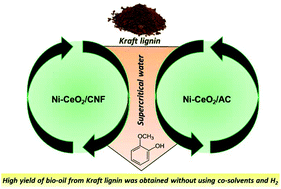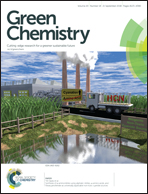Effect of carbon-based materials and CeO2 on Ni catalysts for Kraft lignin liquefaction in supercritical water†
Abstract
Kraft lignin (KL) is a by-product from cellulose production typically treated as a waste or used as a low-value fuel in heat and power generation in the pulp and paper industry. This study explores KL upgrading to monoaromatic compounds using supercritical water (SCW) as reaction medium. The effect of Ni–CeO2 catalysts supported on carbon nanofibers (CNF) and activated carbon (AC) on the product distribution was investigated. These catalysts were prepared by a wet-impregnation method with acetone, and reduced Ni was observed without the use of H2. CNF presented a high degree of stability in SCW. Ni in its reduced state was still present in all spent catalysts, mainly when CNF were the support. While catalysts supported in AC led to high yields of char and gas, a 56 wt% yield of a light liquid fraction, recovered as dichloromethane (DCM)-soluble product and consisting mainly of (methoxy)phenols (>80 mol%), was obtained in a batch reactor at 400 °C, 230 bar, with Ni–CeO2/CNF as a catalyst. A short reaction time was key to avoid the formation of gas and char. This study demonstrates that high yields of DCM-soluble products from KL and low char formation can be obtained by using only SCW and catalysts, an alternative to widely reported approaches like the addition of organic co-solvents (e.g., phenol) and/or H2.



 Please wait while we load your content...
Please wait while we load your content...